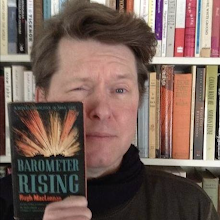Having praised Quebec City and its plaques bleu on Wednesday, I now condemn.
And with good reason.
As one may divine, the above – 755, rue Saint-Jean – was built as a church. Dedicated to St Matthew, patron saint of tax collectors and accountants, its history dates to 1772. The grounds surrounding hold centuries-old bones of the Anglican faithful.
St Matthew's most notable rector was Frederick George Scott (1861-1944). A charismatic Anglo-Catholic, his views on religion fit well – as well as might be hoped – in a predominantly Catholic city. Outside the Church, Scott is best known as the Poet of the Laurentians. He produced thirteen volumes of verse in his 82 years. The favourite in my collection is a signed copy of Selected Poems, which was published in 1933 by Emile Robitaille, 30 Garneau Street, Quebec City.
In 1980, the Anglican Church of Canada gave St Matthew's to the Ville du Quebec. It was remade and remodelled as a library. In 2017, it was named after novelist and memoirist Claire Martin (1914-2014).
I'm a great admirer of Martin, and have sung her praises here and here. She deserves greater recognition in English-speaking Canada. I wonder how she's remembered in French-speaking Canada? In the very same hour I took these photos, I purchased three signed Martin first editions at between six and eight dollars apiece.
I digress.
La bibliothèque Claire-Martin features a very attractive entrance detailing the author's life and work.
This is supplemented with a half-dozen displays lining the library's centre aisle.
Much as I was happy to see them, I was bothered that there was no recognition whatsoever of F.G. Scott. Not only that, there was no recognition of the reverend's third son, Francis Reginald Scott (1899-1985), who was born in the manse overlooking the aforementioned cemetery.
F.G. Scott was one of the most celebrated Canadian poets of the nineteenth and early twentieth centuries. Son F.R. Scott was a founder of both the CCF and the NDP, was Dean of the McGill Law Faculty, fought dictatorial Quebec premier Maurice Duplessis, and defeated the censors in Canada's own Lady Chatterley's Lover trial. F.R. Scott's bibliography consists of over a dozen books, including the Governors General's Award-winning Essays on the Constitution: Aspects of Canadian Law and Politics (Toronto: University of Toronto, 1977) and The Collected Poems of F. R. Scott (Toronto: McClelland & Stewart, 1981). He is recognized as a pioneer in the translation and promotion of Québecois literature.
La bibliotheque Claire-Martin has no books by either man. In fact, there are no books by F.G. Scott in the entire Quebec City public library system. La bibliothèque de Québec has one – one – volume by F.R. Scott, Dialogue sur la traduction, (Montreal: Éditions HMH, 1970). I can't help but think this has everything to do with it having been co-written by Anne Hébert.
 |
| My copy, inscribed by Scott to Hugo McPherson, purchased thirty years ago at the Montreal Antiquarian Book Fair. |
This is not to suggest that the Scott family is unrecognized. Sharp-eyed visitors will spot this century-old plaque dedicated to members of the St Matthew's Anglican Church congregation who fell during the Great War.
The second column bears the name of Henry Hutton Scott, F.G. Scott's son, F.R. Scott's brother, who was killed during the capture of Regina Trench. A chaplain in the First Canadian Division, Reverend Scott shares a moving account of the search for son's body in
The Great War as I Saw It (Toronto: Goodchild, 1922). For those who haven't read it, this short piece from the 1 December 1916 edition of the
Toronto Daily Star gives some idea of what to expect.
All this is to recognize the absence of recognition. La bibliotheque Claire-Martin has no
plaques bleu dedicated to F.G. Scott and F.R. Scott. La bibliotheque Claire-Martin has no books by F.G. Scott and F.R. Scott.
To borrow a phrase used by Jacques Parizeau, it's a bloody disgrace.





















